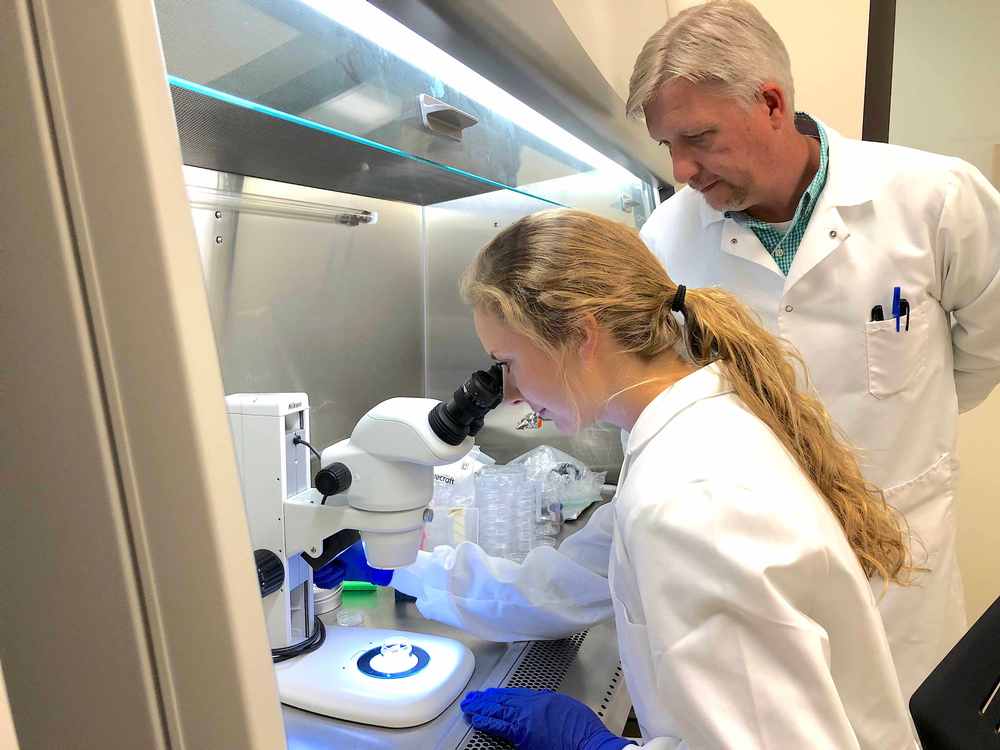News
Origins of ancient Eurasian Nomadic Warriors
October 04, 2018

Prof. Nikitin with student Jessica Hoover, BMS major, who just started in his lab and will be his co-author on an upcoming paper.
Professor Alex Nikitin of the Biology Department is co-author on a paper published in Science Advances today, October 3. The paper deals with the genetic analysis of ancient warrior societies from the Great Eurasian Steppe.
Media release:
Solving the origins of ancient Eurasian Nomadic Warriors with Genetics
October 3, 2018
The Great Eurasian Steppe belt stretches from the eastern corners of Hungary through the northern shores of the Black and Caspian Seas (the Ponto-Caspian steppe) to northeast China. Throughout millennia, the Great Steppe was home to many nomadic groups that made a significant impact on the development of the human civilization. Three major steppe human conglomerates, the Cimmerians, the Scythians and the Sarmatians, re-shaped the political and cultural history of Europe as it progressed from the Iron Age into Classical Antiquity. The Pontic Cimmerians, the earliest of the three, were intrepid contenders for the rule over west Asian and Mesopotamian Iron Age kingdoms. The empire of the Iron Age Scythians, who perfected the nomadic warrior lifestyle, stretched from the Altai Mountains in the east to the Carpathians in the west and was feared by its neighbors, including the Greeks and the Persians. The Sarmatians, who succeeded the Scythians in the Pontic Steppe, were some of the major adversaries of the early Roman Empire, eventually subdued by the Romans and employed to defend the Roman rule of Britain in the 1st century AD. It has even been suggested that the famous King Arthur was a Sarmatian. Up until recently, little was known about the relationship between these three nomadic warrior groups. A major archaeogenetics study, published in the journal Science Advances, sheds light on the biological relationships among the three groups. The study, led by an ancient genetics group from Stockholm University with an international team of collaborators including scholars from Adam Mickiewicz University in Poland, Institute of Archaeology in Ukraine and Grand Valley State University in the US. The study found little evidence of genetic succession among these groups and revealed a composite genetic ancestry in all three that drew from such far-apart corners of Eurasia as the Far East and northern Europe. The uniting theme in the genetic ancestry of the three groups is that they all share common genetic determinants stemming from the Caspian portion of the Great Eurasian Steppe and connecting the Iron Age-Antiquity steppe nomads with the people of the Yamna culture, who made a dramatic genetic and cultural impact on the European continent in the Early Bronze Age such as facilitating the spread of Indo-European languages throughout Europe.
Alexey Nikitin, a Biology professor at Grand Valley State University, who is a co-author on the study, points out that another important discovery the research makes relates to the genetic substructure within the Scythian population. It has been considered that the Scythians were a male dominance-oriented society. One of the study’s subjects came from a treasure-laden grave that belonged to an individual who undoubtfully came from the Scythian warrior elite. This individual was a woman, buried with gold and silver riches, as well as ten arrows and her horse. There have been accounts of the “feminine” side of the Scythian society, made by ancient Greek historians. Herodotus and Strabo called these female warriors the Amazons, who lived among the Scythians but came from a once-mighty female-only warrior group. One of the traditions claimed by the Greek historians to be a part of the Amazon culture involved the Amazons killing their male children. However fantastic this story may sound, the current selection of the Scythian remains revealed sex-specific correlations in the mitochondrial DNA (mtDNA) lineages transmitted through the maternal side (a paper detailing the mtDNA lineage analysis of the current sample selection was published in 2017 in the journal Scientific Reports). It appears that half of the Scythian females in the current selection, including the female warrior from the royal grave discussed earlier, had lineages of east Eurasian descent. At the same time, Scythian male individuals had European and west Asian maternal ancestry and none of the males carried east Eurasian mtDNA lineages. Perhaps, the Amazons living among the Scythians continued to maintain their cultural female-exclusive identity as well as tracing their ancestry through female lines of an east Eurasian origin. Whatever the cultural practices of the Amazons may have been, the absence of males related on the maternal side to the females carrying east Eurasian mtDNA lineages is puzzling. The current study re-ignites the debate about the Amazons, but geneticists do not meddle in the matters of folklore. While archaeogenetic research cannot resolve questions of cultural customs, it can help to get a more comprehensive insight into the life history of humans behind the culture.
The article on the genetic ancestry of ancient Eurasian steppe nomads entitled “Ancient genomes suggest the eastern Pontic-Caspian steppe as the source of western Iron Age nomads” appears in Science Advances on October 3, 2018.
Contact information: Alexey G. Nikitin, Ph.D., Biology Department, Grand Valley State University, 1 Campus Drive, Allendale, MI, 49401, e-mail: [email protected], Phone: (616) 331-2505
